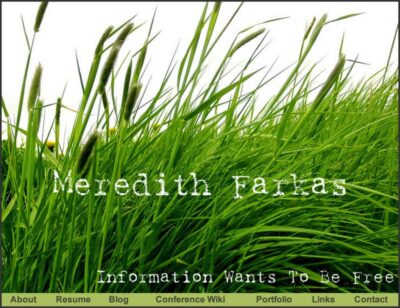Jeff Wisnewski and Frank Cervone
I haven’t really looked much at federated search tools since my post on using MetaLib well over a year ago. So I was very interested to hear Jeff and Frank talk about the recent developments in federated search technology and how many federated search companies are partnering with search companies outside of the library world to bring their customers better ways to manage results.
Goal of Federated Search – Provide a single interface for information resources
Federated search – sits between the patron and the databases. It queries a bunch of resources at once and then presents the results from all of them to the user. Isn’t clear to the user which database they got the info from (is that important to the user? unlikely in most cases).
Features
Support for multiple protocols (Z39.50, SRU/SRW, OAI)
Simple and advanced search (search by specific field)
Post processing of results (combined results)
Integration with other software (courseware, bib management tools)
Advanced result display (clustering, visualization)
Context-sensitive linking (OpenURL)
Open URL is a standard for persistently identifying content. Linking from a citation to the full-text. Finds which databases we have the full-text in and shows the user where it is (or takes them directly to it).
All of these services don’t have to come from the same vendor.
Top Vendors for Fed Search – Ex Libris (MetaLib), WebFeat (PRISM)
New stuff
Built into content platform – CSA Illumina
Visualization of Results – Vivisimo, AquaBrowser, MUSE
Express services – WebFeat
WebFeat EXPRESS is targeted for smaller libraries.
CSA – has federated search built into the product. Searches all databases provided through CSA without the user even knowing.
Endeavor – dumped their own in-house-developed federated search and OpenURL resolvers. New product suite is Discovery Finder and Resolver based on TDnet technology. Has on the fly clustering of results.
Aquabrowser – used to just be for searching the catalog. Now moving into the federated search market. Aquabrowser has really neat visualization of results.
Grokker – Visual search in EBSCO databases. What was funny is that when they tried to pull up EBSCO’s visual search, it crashed IE. lol!
Vivisimo – focus on clustering of results. Used by NLM. Ex Libris is going to be incorporating Vivisimo into MetaLib (HOT!).
OVID Search Solver – uses Muse Global’s technology with custom refinements.
WebFeat – two products. 1) PRISM – custom solution for libraries. Expensive and more for larger libraries. 2) Express – more affordable ($7950 annually). OpenURL compliant. EBSCO A to Z integration. Interface choices. Bowdoin uses it if you’re looking for someone to ask about it.
Keystone and OpenSiteSearch are open source federated search tools.
Federated search really increases full-text retrievals of resources. Jeff talked about how federated search is the best way to really increase the use of databases by patrons. I have certainly heard a lot of students and faculty ask why can’t they search all databases from a single search box, so it is certainly something people at my school are looking for.
Trends: (think I missed a few) Integration with bibliographic management software. More integration of visualization and clustering tools. Federated search is also becoming more affordable, which is a big deal for small and medium-sized libraries whose patrons are also clamoring for these sorts of tools.
We have talked about purchasing a federated search tool at my library in the past, so this was a really helpful talk for me. I’m very happy to see that the companies seem to be focusing largely on how to make it easier for patrons to deal with the results using tools like clustering. Nice to see that prices are getting a bit closer to what a library like mine can afford. Thanks Jeff and Frank!




Thanks for posting this, Meredith — This session was one I had hoped to attend, but I just couldn’t make IL this year.
I’m sure you would have listed it above if it had been mentioned, but did anyone talk about dbWiz? http://dbwiz.lib.sfu.ca/dbwiz/ I’ve been interested in it as an open source alternative and was wondering if it even warranted a mention.
Hi Stewart! They barely mentioned open source options (probably because of the time limits of their talk). It may have been listed on their list of the many many federated search options, but they didn’t keep the list up long enough for me to capture it. I’m sure their slides will be posted on the IL2006 site in a few weeks.
Besides, dbWiz, you should definitely keep your eyes on LibraryFind, at http://dllab.library.oregonstate.edu/content/section/4/28/ . This project includes Jeremy Frumkin, Terry Reese, Dan Chudnov, and other really savvy folks who are working on an open source metasearch application in Ruby on Rails.
Did anyone happen to mention what product Library of Congress is now using for their beta federated search of digital collections, OPAC, and website?
http://www.loc.gov/search/new/
No, I don’t think anyone mentioned it. I hadn’t even heard about it until you mentioned it.